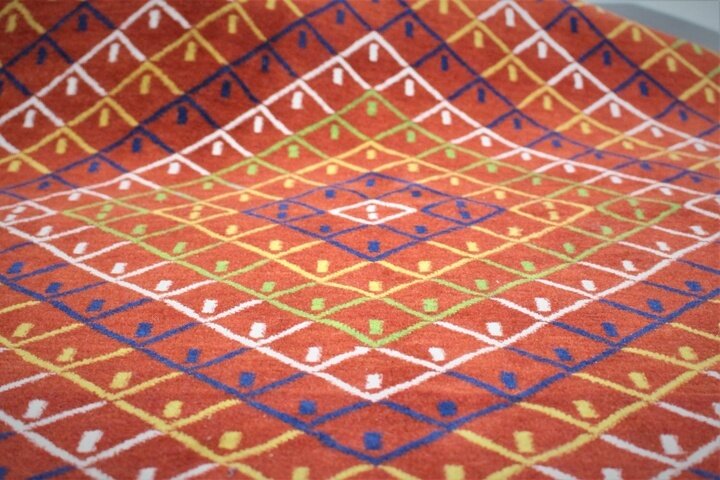First Gelij carpet of Mazandaran province woven

TEHRAN--For the first time in Mazandaran province, an authentic carpet with a “Gelij” design and inspired by ancient motifs from the Sassanid period was created entirely by hand: a luxurious work that revives a connection between the ancient art of northern carpet weaving and the aesthetics of historical architecture in a new format.
According to IRIB, Kobra and Zahra Baqeri, two artist sisters from Dodangeh in Sari, designed and weaved the first Mazandaran handwoven carpet with authentic Gelij pattern.
The pattern, inspired by the “bird's foot” motif from the Sassanid period, which, with more than 40 days of continuous and thoughtful effort, showcases a unique combination of traditional symbols, the visual heritage of the ancient pottery, and native carpet weaving.
Zahra Baqeri emphasized the innovative nature of this design in the field of carpet weaving in the region and said: “Gelij pattern is implemented in Mazandaran carpet weaving for the first time. We have been weaving carpets with our mother since we were children, but we were always thinking about creating something new; a design that was both true to the roots and eye-catching.”
Kobra Baqeri, who was responsible for the color composition and arrangement of the patterns in this work, said: “Gelij, with its regular geometric structure, is both pleasing to the eye and a symbol of our inner order and cultural continuity. We wanted to weave something that would attract the gaze of every viewer to the authenticity and traditional beauty of Iran.”
With emphasis on the potential of Gelij art and the other traditional Mazandaran motifs, these artists called for targeted support, facilitating the process of registering works, providing facilities to equip the workshops, and providing a suitable platform for their presence in domestic and international markets.
This 1.5 x 1-meter Gelij carpet, woven using plant-based yarns, in addition to its artistic aspect, carries a story of the connection of generations and the revival of a forgotten heritage. This work is among the noble works of Mazandaran handicrafts and is undergoing the preliminary stages for provincial registration.
More than a work of art, the Gelij carpet is a symbol of the cultural ecosystem of Mazandaran; a story of female creativity, reliance on native memory, and the effort to preserve heritage in the path of development. This work is the initiator of a new trend in the art of carpet weaving in the north of the country.
Carpet weaving is widespread in cities and provinces across Iran, with some cities like Tabriz, Isfahan, and Kashan being particularly well-known.
Iran's handmade carpet exports have experienced approximately a four-percent growth in value in the past Iranian calendar year (ended on March 20), after two decades of decline, according to Zahra Kamani, the head of Iran National Carpet Center.
Putting the value of the exported handmade carpets at $39.7 million in the past year, she said that the Iranian carpets were exported to 65 countries around the world.
Germany, the UAE, Japan, and China are among the top four export destinations in the previous year, collectively accounting for over $22 million of the export, she added.
The growth has been attributed to the removal or revision of restrictive regulations, as well as supportive measures by the National Carpet Center, Kamani stated and noted: “A new initiative launched by the Ministry of Industry, Mining, and Trade, alongside the National Carpet Center, aims to enhance the global standing of handmade carpets.
With synergy in monetary and banking systems and supportive measures from relevant organizations, further growth in exports is anticipated.”
KD
Leave a Comment